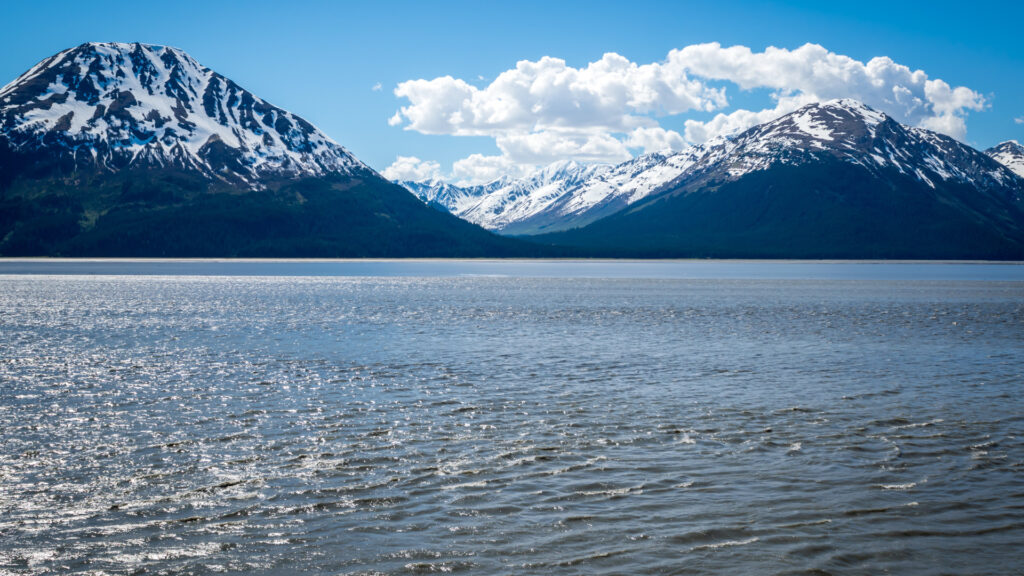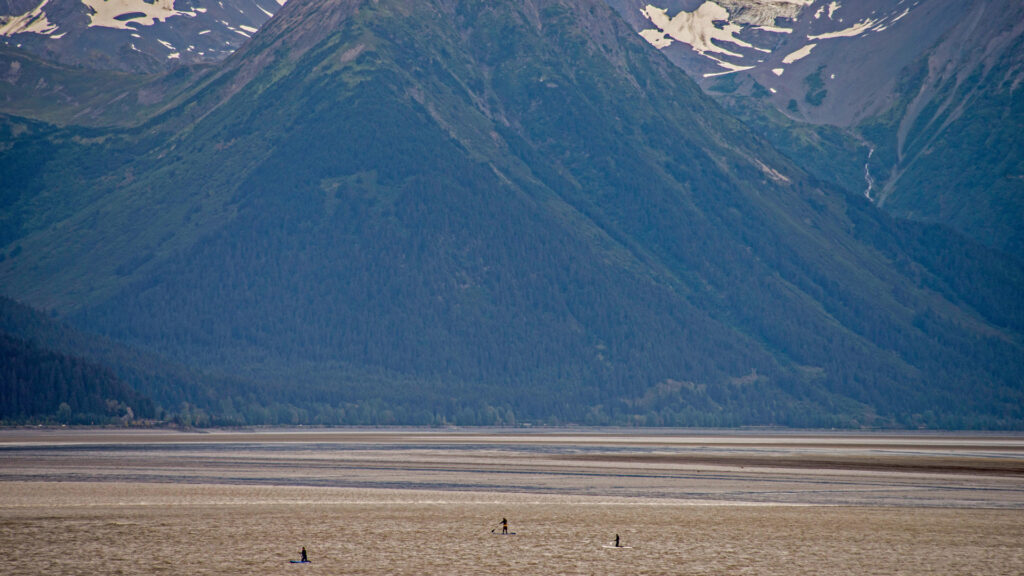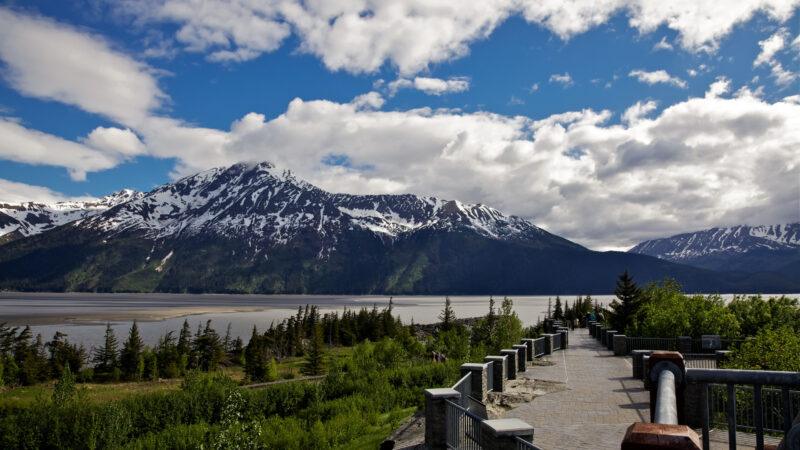Table of Contents Show
Have you ever heard of a bore tide? We hadn’t until we visited Hope, Alaska. This natural phenomenon only occurs in a few dozen places around the world. We were lucky enough to see a bore tide in Alaska along the Turnagain Arm.
So let’s look closer at the bore tide in Alaska — what it is, what causes it, and where and when to see it. It’s fascinating!
What Is a Bore Tide?
The moon’s phases affect the tides. Under certain circumstances, a full or new moon will create a bore tide.
This is a rush of seawater that comes in after extreme minus-low tides. These bore tides occur in a bay with shallow, narrow inlets and travel upstream toward land, thus reversing the water’s current.
There are about 60 bore tides around the world, including the bore tide in Alaska. Although each one poses different threats depending on the nature of the waterway, bore tides are always turbulent.
The surging waters change in velocity, and this mixing of turbulence within the water can be felt over considerable distances. The low-frequency roar can also be heard from far away.

What’s So Special About the Bore Tide in Alaska?
You won’t find many bore tides in the United States. One of the most famous in the world, however, occurs in the Turnagain Arm in Alaska. One reason it occurs here is its geographical location, as it is far north and the only one bordered by mountains.
Thus, the “show” is spectacular, dramatic, and easily accessible. The entire 40-50-mile length can be seen from the Seward Highway.
Where Is the Turnagain Arm?
If you’ve read our article “Our Review of Porcupine Campground in Hope, Alaska,” you know we stayed along the Turnagain Arm during our road trip through Alaska. This waterway separates Anchorage from the Kenai Peninsula in southern Alaska.
Hope sits on the southern shoreline. Highway 1, also known as the Seward Highway, travels from Anchorage, along the northern shoreline of the Turnagain Arm, and around the Kenai Peninsula. The Gulf of Alaska feeds the inlet.
What Causes the Bore Tide in Alaska?
The bore tide in Alaska can occur twice a day when an extremely low tide crashes into an extremely high tide. A minus low tide and a 27-foot high tide are required. It usually happens about two or three hours after the low tide time in Anchorage.
Occasionally, you’ll see surfers enjoying the 10-foot waves, speeding towards the shoreline at 10-15 mph. The bore tide in Alaska stretches 40-50 miles along the Turnagain Arm, one of the longest in the world.
Where Can I See the Bore Tide in Alaska?
As already mentioned, this particular bore tide is easily accessible. You can watch the entire phenomenon from start to finish. Just park your car off the side of the road at one of the turnouts along Highway 1.
You can even watch the bore tide again and again since it takes hours to travel from the mouth to the end of the Turnagain Arm. Pull into the first turnout and watch the bore tide go by. Then drive to the next one and watch it again.
You’ll also find a few specific places that allow you to see the bore tide the best. Beluga Point is about 20 minutes from Anchorage. The overlook provides 180-degree views of Turnagain Arm and has spotting scopes.
Bird Ridge is another popular spot to watch the bore tide in Alaska, but it’s more distant than the Beluga Point Overlook. But you’ll find plenty of parking and have a wider view of the Turnagain Arm. We stayed in Hope at Porcupine Campground.
This lies much farther down the road since it’s on the other side of the inlet. But if you’re camping at this campground, you have another great viewing spot.
Keep in Mind: Alaska is home to 23 stunning national parks! Here’s everything you need to know about Alaska National Parks
When Can I See the Bore Tide in Alaska?
Your best chance of witnessing the bore tide in Alaska is during the five-day window of a new or full moon. Then check the tide charts to find the times for the two Anchorage low tides occurring each day.
Remember, low tide has to be extremely low to generate a large bore tide. This schedule can also help predict the best opportunities to see the bore tide in Alaska.
If you can time up a visit with the spring or fall equinox, you have an even greater chance of seeing a large bore tide in the Turnagain Arm.

What Kinds of Wildlife Can I See Along the Turnagain Arm?
Perhaps one of the reasons the bore tide in Alaska is so special is also because of the wildlife. Harbor seals and beluga whales are commonly spotted.
Harbor seals will ride the tide into the Turnagain Arm, and beluga whales will come in about 30 minutes later. After the water rises, they feed on the fish that have come in on the tide.
Keep in Mind: Is the Alaskan Giant Polar Bear Real? Click the link to find out!
Is the Bore Tide in Alaska Worth Seeing?
The bore tide in Alaska is an amazing natural phenomenon and absolutely worth seeing! Although you need a bit of luck to witness a large bore tide, the consistency and predictability of the occurrences increase your chances.
So whether you’re camping in Hope at Porcupine Campground or visiting Anchorage, consider finding a turnout or overlook at the Turnagain Arm one day to see the Alaska bore tide.
Will you take a drive to Turnagain Arm to see the bore tide?







I just added the Alaskan bore tide to my list of things I want to see and experience. Thank you for introducing me to something so wonderful that I never even knew even existed.